LG DLG7201VE/00, DLE7200WE/00, DLE7200VE/00 Owner’s Manual
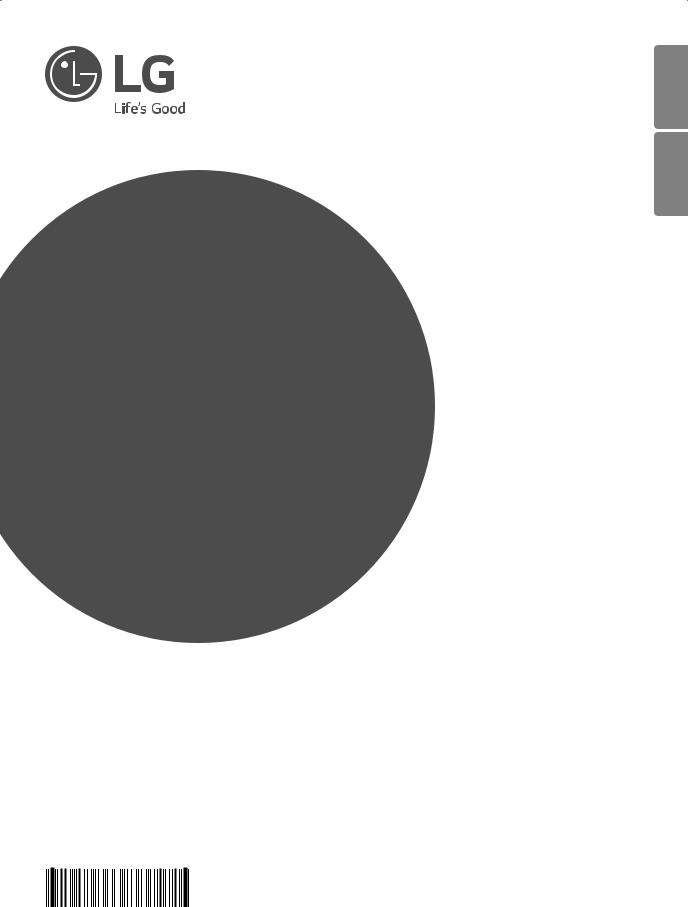
pañoEs lENGLISH
OWNER’S MANUAL
DRYER
Read this owner’s manual thoroughly before operating the appliance and keep it handy for reference at all times.
DLE7200*E (Elec)
DLG7201*E (Gas)
MFL67731095 |
www.lg.com |
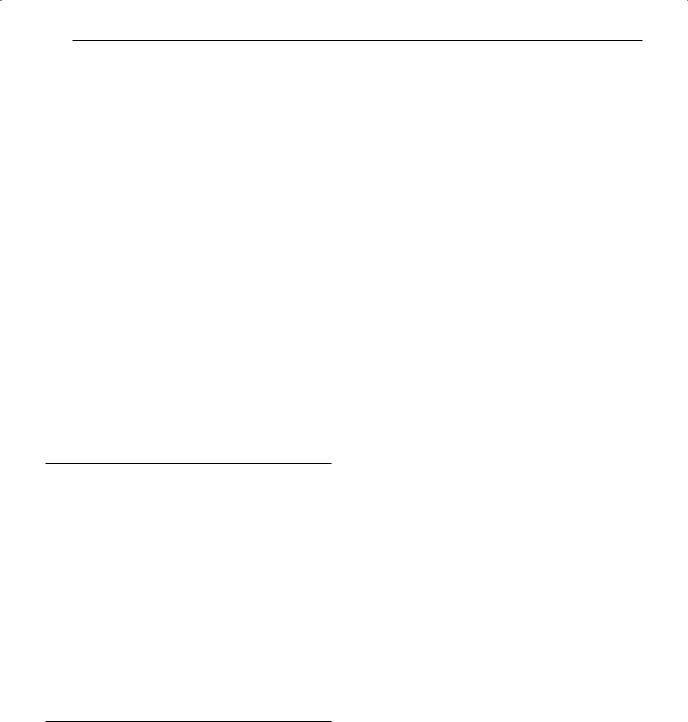
2 TABLE OF CONTENTS
TABLE OF CONTENTS
3 |
PRODUCT FEATURES |
|
46 mAINTENANCE |
||
|
|
46 |
Regular Cleaning |
||
4 |
SAFETY INSTRUCTIONS |
47 |
Troubleshooting |
||
5 |
IMPORTANT SAFETY INSTRUCTIONS |
||||
|
|
|
|||
7 |
GROUNDING INSTRUCTIONS |
47 |
FAQs: Frequently Asked Questions |
||
8 |
CALIFORNIA SAFE DRINKING WATER AND |
47 |
User Support Videos |
||
|
TOXIC ENFORCEMENT ACT |
48 |
Before Calling for Service |
||
9 |
FCC Notice |
|
|
|
|
9 |
FCC RF Radiation Exposure Statement |
|
55 |
SMART DIAGNOSIS™ |
|
10 |
PRODUCT SPECIFICATIONS |
||||
55 |
Using Smart DiagnosisTM |
||||
|
|
||||
11 |
PRODUCT OVERVIEW |
56 |
WARRANTY (USA) |
||
11 |
Parts |
||||
|
|
|
|||
11 |
Accessories |
|
|
|
|
11 |
Safety Tether Kit |
|
|
|
|
11Two-Way Reversible Door (on some models)
12INSTALLATION
12Installation Overview
12Product Specifications
13Installation Location Requirements
13Clearances
15Leveling the Dryer
15Reversing the Door
23Installing the Side Vent Kit
24Venting the Dryer
26Connecting Gas Dryers
28Connecting Electric Dryers
32Final Installation Check
33Installation Test (Duct Check)
35 OPERATION
35Using the Dryer
36Check the Lint Filter Before Every Load
36Sorting Loads
36Loading the Dryer
37Using the LG EasyLoadTM
38Control Panel
40 Cycle Guide
42 Cycle Settings and Options
44 SMART FUNCTIONS

PRODUCT FEATURES 3
PRODUCT FEATURES
Easy-to-Use Control Panel
An entire selection of user-friendly functions make operating the dryer easy.
Two-Way Easy-Access Reversible Door
The LG EasyLoadTM can be tilted open from the top, hamper-style, allowing you to easily load the dryer without items falling on the floor. The door still swings open to provide easy access for unloading or loading of bulkier items. The door hinge can be reversed to adjust to the installation location.
Flow SenseTM Duct Blockage Sensing System Indicator
The Flow SenseTM duct blockage sensing system detects and alerts you to restrictions in the installed household ductwork that reduce exhaust airflow through the dryer. If you see the alert: Clean or repair the ducts to remove the restrictions. Keep your ducts free of blockage to help increase efficiency and reduce long drying times caused by blocked ducts.
Smart ThinQ™
Download the new LG smart phone app to set options, self-diagnose and troubleshoot problems with the appliance, and other useful features. This function uses Wi-Fi.
E |
S |
D |
|
C ER T
I
I
G |
|
|
|
N |
|
|
|
D |
|
E |
|
I |
|
|
F |
|
|
Protocol P154
Sanitization Performance of Residential Clothes dryer
ENGLISH
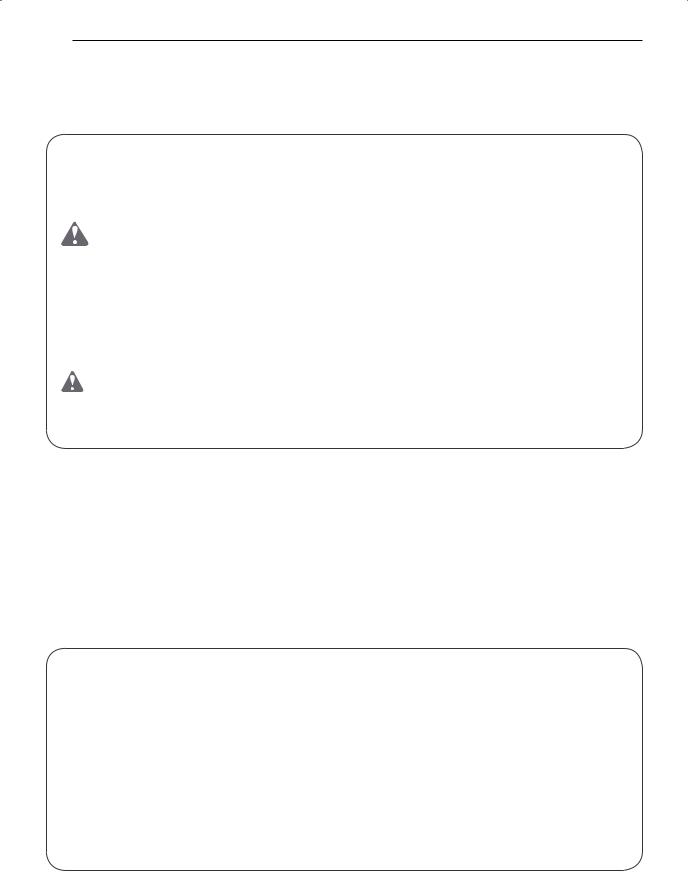
4 SAFETY INSTRUCTIONS
SAFETY INSTRUCTIONS
READ ALL INSTRUCTIONS BEFORE USE
Your safety and the safety of others is very important.
We have provided many important safety messages in this manual and on your appliance. Always read and obey all safety messages.
This is the safety alert symbol.
This symbol alerts you to potential hazards that can kill or hurt you and others.
All safety messages will follow the safety alert symbol and either the word DANGER, WARNING, or CAUTION.
These words mean:
 DANGER - You will be killed or seriously injured if you do not immediately follow instructions.
DANGER - You will be killed or seriously injured if you do not immediately follow instructions.
 WARNING - You may be killed or seriously injured if you do not follow instructions.
WARNING - You may be killed or seriously injured if you do not follow instructions.
CAUTION - You may be slightly injured or cause damage to the product if you do not follow instructions.
All safety messages will tell you what the potential hazard is, tell you how to reduce the chance of injury, and tell you what may happen if the instructions are not followed.
 WARNING – Risk of Fire
WARNING – Risk of Fire
Install the clothes dryer according to the manufacturer’s instructions and local codes.
•• Do not install a clothes dryer with flexible plastic venting materials. If flexible metal (foil type) duct is installed, it must be of a specific type identified by the appliance manufacturer as suitable for use with clothes dryers. Flexible venting materials are known to collapse, be easily crushed, and trap lint. These conditions will obstruct clothes dryer airflow and increase the risk of fire.
•• To reduce the risk of severe injury or death, follow all installation instructions.
•• Save these instructions.
 WARNING
WARNING
FIRE OR EXPLOSION HAZARD
Failure to follow safety warnings exactly could result in serious injury, death or property damage.
—Do not store or use gasoline or other flammable vapors and liquids in the vicinity of this or any other appliance.
—WHAT TO DO IF YOU SMELL GAS
•Do not try to light any appliance.
•Do not touch any electrical switch; do not use any phone in your building.
•Clear the room, building or area of all occupants.
•Immediately call your gas supplier from a neighbor’s phone. Follow the gas supplier’s instructions.
•If you cannot reach your gas supplier, call the fire department.
—Installation and service must be performed by a qualified installer, service agency or the gas supplier.

SAFETY INSTRUCTIONS 5
IMPORTANT SAFETY INSTRUCTIONS
 Warning
Warning
To reduce the risk of fire, electric shock, or injury to persons when using your appliance, follow basic precautions, including the following:
Installation
•• Keep area around the exhaust opening and adjacent surrounding areas free from the accumulation of lint, dust, and dirt.
•• Do not install or store this appliance where it will be exposed to the weather.
•• Do not place items exposed to cooking oils in your dryer. Items contaminated with cooking oils may contribute to a chemical reaction that could cause a load to catch fire.
•• Properly ground the dryer to conform with all governing codes and ordinances. Follow the details in the installation instructions. Electric shock may result if the dryer is not properly grounded.
•• Before use, the dryer must be properly installed as described in this manual. Electric shock may result if the dryer is not properly grounded.
•• Install and store the dryer where it will not be exposed to temperatures below freezing or exposed to the weather.
•• All repairs and servicing must be performed by authorized service personnel unless specifically recommended in this Owner’s Manual. Use only authorized factory parts. Failure to follow this warning may result in serious injury, fire, electric shock, or death.
•• To reduce the risk of electric shock, do not install the dryer in humid spaces. Failure to follow this warning may result in serious injury, fire, electric shock, or death.
•• Connect to a properly rated, protected, and sized power circuit to avoid electrical overload. Improper power circuits may melt, creating electric shock and/or fire hazard.
•• Remove all packing items and dispose of all shipping materials properly. Failure to do so may result in burns, fire, explosion, or death.
•• Place the dryer at least 18 inches (45.7 cm) above the floor for a garage installation. Failure to do so may result in burns, fire, explosion, or death.
•• Keep all packaging from children. Packaging material can be dangerous for children. There is a risk of suffocation.
•• Do not install near another heat source such as a stove, oven or heater. Failure to follow this warning may result in product deformation, smoke, or fire.
•• Do not place candles, smoking materials, or other flammables on top of the product. Dripping wax, smoke, or fire may result.
•• Remove all protective vinyl film from the product.
Failure to do so may result in product damage, smoke, or fire.
•• Gas dryers MUST be exhausted to the outside.
Failure to follow these instructions may result in fire or death.
•• The dryer exhaust system must be exhausted to the outside of the dwelling. If the dryer is not exhausted outdoors, some fine lint and large amounts of moisture will be expelled into the laundry area. An accumulation of lint in any area of the home may create a health and fire hazard.
•• Use only rigid, semi-rigid or flexible metal 4-inch (10.2 cm) diameter duct inside the dryer cabinet or for exhausting to the outside. Use of plastic or other combustible ductwork may cause a fire. Punctured ductwork may cause a fire if it collapses or becomes otherwise restricted in use or during installation.
•• Ductwork is not provided with the dryer, and you should obtain the necessary ductwork locally. The end cap should have hinged dampers to prevent backdraft when the dryer is not in use. Failure to follow these instructions may result in fire or death.
•• The exhaust duct must be 4 inches (10.2 cm) in diameter with no obstructions. The exhaust duct should be kept as short as possible. Make sure to clean old ducts before installing your new dryer.
Failure to follow these instructions may result in fire or death.
•• Rigid, semi-rigid or flexible metal ducting is recommended for use between the dryer and the wall. All non-rigid metal transition duct must be UL-listed. Use of other materials for transition duct could affect drying time. Failure to follow these instructions may result in fire or death.
•• Do not use sheet metal screws or other fasteners which extend into the duct that could catch lint and reduce the efficiency of the exhaust system. Secure all joints with duct tape. For complete details, follow the Installation Instructions. Failure to follow these instructions may result in fire or death.
•• Certain internal parts are intentionally not grounded and may present a risk of electronic shock only during servicing.
Service personnel - do not contact the following parts while the appliance is energized: CONTROL BOARD
ENGLISH

6 SAFETY INSTRUCTIONS
Operation
•• Read all instructions before using the appliance.
•• Do not dry articles that have been previously cleaned in, washed in, soaked in, or spotted with gasoline, dry-cleaning solvents, or other flammable or explosive substances, as they give off vapors that could ignite or explode.
•• Do not reach into the appliance if the drum is moving.
•• Do not allow children to play on or in the appliance. Close supervision of children is necessary when the appliance is used near children.
•• Do not use fabric softeners or products to eliminate static unless recommended by the manufacturer of the fabric softener or product.
•• Do not use heat to dry articles containing foam rubber or similarly textured rubber-like materials.
•• Do not tamper with controls.
•• Always check the inside of the dryer for foreign objects. Failure to follow these instructions may result in fire or death.
•• Do not store plastic, paper, or clothing that may burn or melt on top of the dryer during operation. Failure to follow these instructions may result in fire or death.
•• Be careful when opening and closing the door. Fingers and hands can get caught in the door and cause injury if the door drops forward unexpectedly.
•• Do not place heavy items on or lean against the top of the door when it is open.
•• Do not attempt to pull the hamper door open more than 40 degrees. The dryer could tip forward, causing injury or damage.
•• Do not place items on the top of the dryer.
Steam (steam model):
•• Do not open the dryer door during steam cycles. Failure to follow these instructions may result in a burn hazard.
•• Do not dry articles that have been previously cleaned in, washed in, soaked in, or spotted with gasoline, dry-cleaning solvents, or other flammable or explosive substances as they give off vapors that could ignite or explode. Failure to follow these instructions may result in fire or death.
•• Do not fill the steam feeder with gasoline, dry cleaning solvents, or other flammable or explosive substances. Failure to follow these instructions may result in fire or death.
•• Do not touch the steam nozzle in the drum during or after the steam cycles. Failure to follow these instructions may result in a burn hazard.
•• Do not fill the steam feeder with hot water (over 86 °F/30 °C). Failure to follow these instructions may result in a burn hazard.
Maintenance
•• Do not repair or replace any part of the appliance or attempt any servicing unless specifically recommended in the user maintenance instructions or in published user-repair instructions that you understand and have the skills to carry out.
•• Clean the lint filter before or after each load.
•• The interior of the appliance and exhaust duct should be cleaned periodically by qualified service personnel.
•• Before the appliance is removed from service or discarded, remove the door to the drying compartment.
•• Certain internal parts are intentionally not grounded and may present a risk of electronic shock only during servicing.
Service personnel - do not contact the following parts while the appliance is energized: CONTROL BOARD
 Warning
Warning
Fire Hazard
Failure to follow safety warnings exactly could result in serious injury, death or property damage.
Do not install a booster fan in the exhaust duct.
Install all clothes dryers in accordance with the installation instructions of the manufacturer of the dryer.
SAVE THESE INSTRUCTIONS

SAFETY INSTRUCTIONS 7
GROUNDING INSTRUCTIONS
 Warning
Warning
Improper connection of the equipment-grounding conductor may result in a risk of electric shock. Check with a qualified electrician or service person if you are in doubt that the appliance is properly grounded.
•• This appliance must be grounded. In the event of malfunction or breakdown, grounding will reduce the risk of electric shock by providing a path of least resistance for electric current.
•• This appliance must be equipped with a cord having an equipment-grounding conductor and a grounding plug. The plug must be plugged into an appropriate outlet that is properly installed and grounded in accordance with all local codes and ordinances.
•• Do not modify the plug. If it will not fit the outlet, have a proper outlet installed by a qualified electrician.
•• This appliance must be connected to a grounded metal, permanent wiring system or an equipment-grounding conductor must be run with the circuit conductors and connected to the equipment-grounding terminal or lead on the appliance. Electric shock may result if the dryer is not properly grounded.
•• The dryer should always be plugged into its own individual electrical outlet which has a voltage rating that matches the rating plate. This provides the best performance and also prevents overloading house wiring circuits which can cause a fire hazard from overheated wires.
•• Never unplug the dryer by pulling on the power cord. Always grip the plug firmly and pull straight out from the outlet. The power cord may be damaged, resulting in a risk of fire and electric shock.
•• Repair or replace immediately all power cords that have become frayed or otherwise
damaged. Do not use a cord that shows cracks or abrasion damage along its length or at either end. The power cord may melt, creating electric shock and/or fire hazard.
•• When installing or moving the dryer, be careful not to pinch, crush, or damage the power cord.
This will prevent injury and damage to the dryer from fire and electric shock.
•• Do not, under any circumstances, cut or remove the ground prong from the power cord.
To prevent personal injury or damage to the dryer, the electrical power cord must be plugged into a properly grounded outlet.
•• For personal safety, this dryer must be properly grounded. Failure to do so may result in electric shock or injury.
•• Refer to the installation instructions in this manual for specific electrical requirements for your model. Failure to follow these instructions may create an electric shock hazard and/or a fire hazard.
•• This dryer must be plugged into a properly grounded outlet. Electrical shock may result if the dryer is not properly grounded. Have the wall outlet and circuit checked by a qualified electrician to make sure the outlet is properly grounded. Failure to follow these instructions may create an electric shock hazard and/or a fire hazard.
ENGLISH
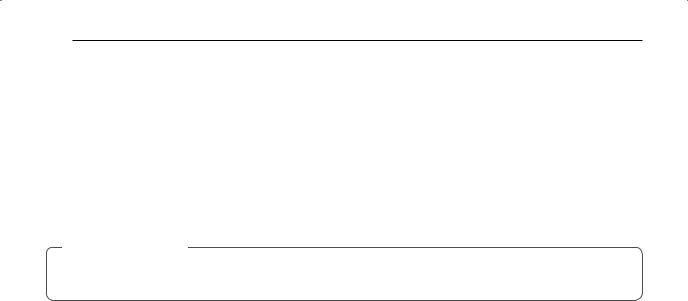
8 SAFETY INSTRUCTIONS
CALIFORNIA SAFE DRINKING WATER AND TOXIC ENFORCEMENT ACT
•• This act requires the Governor of California to publish a list of substances known to the state to cause cancer, birth defects, or other reproductive harm and requires businesses to warn customers of potential exposure to such substances.
•• Gas appliances can cause minor exposure to four of these substances, namely benzene, carbon monoxide, formaldehyde, and soot, caused primarily by the incomplete combustion of natural gas or LP fuels.
•• Properly adjusted dryers will minimize incomplete combustion. Exposure to these substances can be minimized further by properly venting the dryer to the outdoors.
 Warning
Warning
This product contains chemicals known to the State of California to cause cancer and birth defects or other reproductive harm. Wash hands after handling.

SAFETY INSTRUCTIONS 9
FCC Notice (For transmitter module contained in this product)
This equipment has been tested and found to comply with the limits for a Class B digital device, pursuant to Part 15 of the FCC Rules. These limits are designed to provide reasonable protection against harmful interference in a residential installation. This equipment generates, uses, and can radiate radio frequency energy and, if not
installed and used in accordance with the instructions, may cause harmful interference to radio communications. However, there is no guarantee that interference will not occur in a particular installation. If this equipment does cause harmful interference to radio or television reception, which can be determined by turning the equipment off and on, the user is encouraged to try to correct the interference by one or more of the following measures:
-Reorient or relocate the receiving antenna.
-Increase the separation between the equipment and the receiver.
-Connect the equipment to an outlet on a circuit different from that to which the receiver is connected.
-Consult the dealer or an experienced radio/TV technician for help.
This device complies with part 15 of the FCC Rules. Operation is subject to the following two conditions:
(1)this device may not cause harmful interference and
(2)this device must accept any interference received, including interference that may cause undesired operation of the device.
Any changes or modifications in construction of this device which are not expressly approved by the party responsible for compliance could void the user’s authority to operate the equipment.
FCC RF Radiation Exposure Statement
This equipment complies with FCC radiation exposure limits set forth for an uncontrolled environment. This transmitter must not be co-located or operating in conjunction with any other antenna or transmitter.
This equipment should be installed and operated with a minimum distance of 20 cm (7.8 inches) between the antenna and your body. Users must follow the specific operating instructions for satisfying RF exposure compliance.
ENGLISH

10 SAFETY INSTRUCTIONS
PRODUCT SPECIFICATIONS
Model |
LCW-004 |
Frequency Range |
2412 MHz to 2462 MHz |
|
|
|
IEEE 802.11b: 22.44 dBm |
Output Power (Max) |
IEEE 802.11g: 24.68 dBm |
|
IEEE 802.11n: 24.11 dBm |
|
|
OPEN SOURCE SOFTWARE NOTICE
To obtain the source code contained in this product, under GPL, LGPL, MPL and other open source licenses, please visit http://opensource.lge.com.
In addition to the source code, all referred license terms, warranty disclaimers and copyright notices are available for download.
LG Electronics will also provide open source code on CD-ROM for a fee covering the cost of performing such distribution (including media, shipping and handling) upon email request to opensource@lge.com.
This offer is valid for three (3) years from the date of purchase of the product.

PRODUCT OVERVIEW 11
PRODUCT OVERVIEW
Parts
Control |
Reversible |
|
|
|
panel |
|
|
||
door |
Terminal block |
Power cord |
||
|
||||
|
|
access panel |
||
|
|
location |
||
|
|
(electric models) |
||
|
|
(gas models) |
||
|
|
|
|
|
|
Water inlet valve |
|
Lint filter |
Gas connection |
(on some models) |
|
|
||
Leveling |
location |
|
|
|
|
||
|
(gas models) |
|
|
feet |
|
Exhaust duct |
|
|
|
||
|
|
|
outlet |
ENGLISH
Accessories
Included Accessories
Safety Tether Kit (on some models)
Optional Accessories
Drying rack |
Side vent kit |
(sold separately) |
(sold separately) |
No. 3750EL0001C |
Kit No. 383EEL9001B |
Two-Way Reversible Door (on some models)
Release
Hamper
door
Swing door
The LG EasyLoad™ feature allows you to open the dryer door from the top, hamper-style, when loading the dryer to help guide clothes into the drum and prevent them from falling onto the floor. When unloading the dryer or loading bulkier items, use the swing door for easy access to the drum.
Safety Tether Kit
This optional kit helps prevent the dryer tipping if children climb on the door or if someone should fall onto the door. It is recommended that you install this kit, depending on your situation, but it is not required. Follow the customer installation instructions included with the kit to properly install the kit. If you do not install the kit, store it out of reach of children.
NOTE
•• For your safety and for extended product life, use only authorized components. The manufacturer is not responsible for product malfunction or accidents caused by the use of separately purchased unauthorized components or parts.
•• The images in this guide may be different from the actual components and accessories, which are subject to change by the manufacturer without prior notice for product improvement purposes.
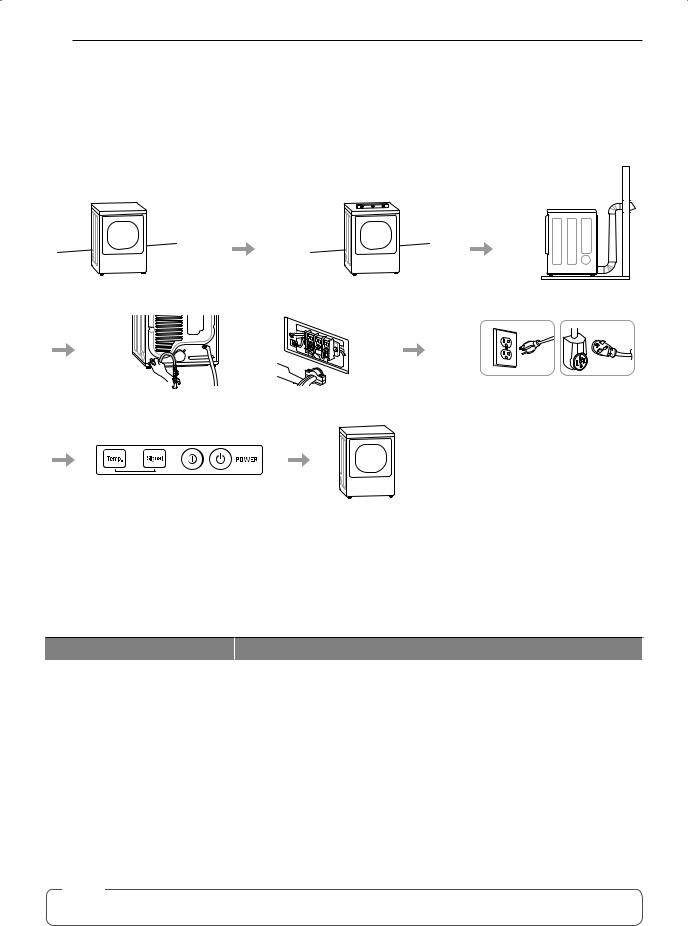
12 INSTALLATION
INSTALLATION
Installation Overview
Please read the following installation instructions first after purchasing this product or transporting it to another location.
Check and choose |
Level the dryer |
Vent the dryer |
the proper location |
|
|
|
Connect electric dryers |
Gas dryer |
Electric dryer |
Connect gas dryers |
Plug in the power cord |
||
|
|
||
Installation test |
Test run |
Product Specifications
The appearance and specifications listed in this manual may vary due to constant product improvements.
Dryer Models |
DLE7200*E, DLG7201*E |
|
Electrical requirements |
Please refer to the rating label regarding detailed information. |
|
|
|
|
Gas requirements |
NG: 4–10.5-inch WC |
|
LP: 8–13-inch WC |
||
|
||
|
|
|
Dimensions |
27” (W) X 28 15/16” (D) X 44 1/4” (H), 50 1/4” (D with door open) |
|
68.6 cm (W) X 73.4 cm (D) X 112.3 cm (H), 127.5 cm (D with door open) |
||
|
||
|
|
|
Net weight |
Gas dryer : 132.5 lb (60.1 Kg) |
|
Electric dryer : 129.8 lb (58.9 Kg) |
||
|
||
|
|
|
Drying capacity |
|
|
- Normal cycle |
IEC 7.3 cu.ft. (22.5 lb/10.2 kg) |
|
|
|
NOTE
Model numbers can be found on the cabinet inside the door.
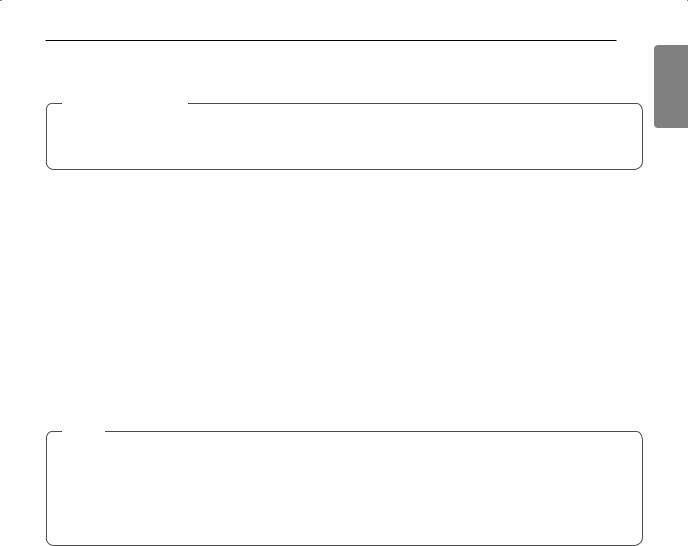
INSTALLATION 13
Installation Location Requirements
 Warning
Warning
Read all installation instructions completely before installing and operating the dryer! It is important that you review this entire manual before installing and using the dryer. Detailed instructions concerning electrical connections, gas connections, and exhaust requirements are provided on the following pages.
The installation requires:
•• A location that allows for proper exhaust installation. A gas dryer must be exhausted to the outdoors. See Venting the Dryer.
•• A grounded electrical outlet located within 2 ft. (61 cm) of either side of the dryer. See Connecting Electric Dryers .
•• A sturdy floor to support the total dryer weight of 200 lb (90.7 kg). The combined weight of a companion appliance should also be considered.
•• No other fuel-burning appliance can be installed in the same closet as a dryer.
Do not operate the dryer at temperatures below 45 °F (7 °C). At lower temperatures, the dryer might not shut off at the end of an automatic cycle. This can result in longer drying times. The dryer must not be installed or stored in an area where it will be exposed to water and/or weather. Check code requirements. Some codes limit, or do not permit, installation of the dryer in garages, closets, mobile homes or sleeping quarters. Contact your local building inspector.
NOTE
•• The floor must be level, with a maximum slope of 1 inch (2.5 cm) under the entire dryer.
Clothes may not tumble properly, and automatic sensor cycles may not operate correctly if dryer is not level.
•• For a garage installation, you will need to place the dryer at least 18 inches (46 cm) above the floor. The standard pedestal is 15 inches (38.1 cm). You will need 18 inches (46 cm) from the garage floor to the bottom of the dryer.
ENGLISH
Clearances
Installation Spacing for Recessed Area or Closet Installation
The following spacing dimensions are recommended for this dryer. This dryer has been tested for clearances of 1 inch (2.5 cm) on the sides and rear. Recommended clearances should be considered for the following reasons:
•• Additional clearances should be considered for ease of installation and servicing.
•• Additional clearances might be required for wall, door and floor moldings.
•• Additional clearances should be considered on all sides of the dryer to reduce noise transfer.
For closet installation, with a door, minimum ventilation openings in the top and bottom of the door are required. Louvered doors with equivalent ventilation openings are acceptable.
•• Companion appliance spacing should also be considered.
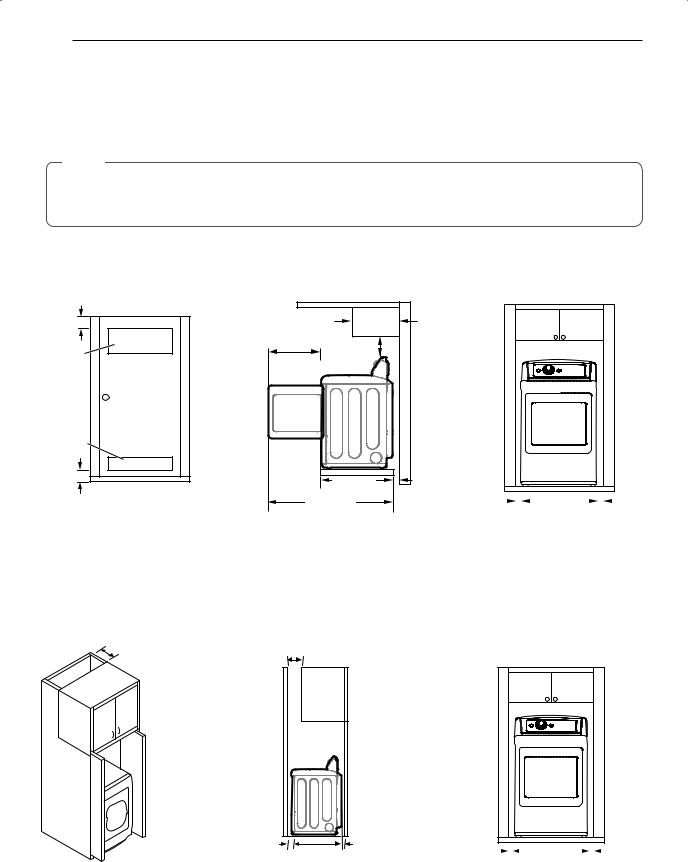
14 INSTALLATION
Closet Ventilation Requirements
Closets with doors must have both an upper and lower vent to prevent heat and moisture buildup in the closet. One upper vent opening with a minimum opening of 48 sq. in. (310 cm2) must be installed no lower than 6 feet above the floor. One lower vent opening with a minimum opening of 24 sq. in. (155 cm2) must be installed no more than one foot above the floor. Install vent grills in the door or cut down the door at the top and bottom to form openings. Louvered doors with equivalent ventilation openings are also acceptable.
NOTE
There should be at least a little space around the dryer (or any other appliance) to eliminate the transfer of vibration from one appliance to another. If there is enough vibration, it could cause appliances to make noise or come into contact, causing paint damage and further increasing noise.
Installation Spacing for Recessed Area or Closet
3" |
|
|
(7.6 cm) |
|
|
|
|
14" max.* |
|
21 1/4" |
(35.6 cm) |
|
|
|
48 in.2 |
(54 cm) |
18" min. |
|
(45.7 cm) |
|
(310 cm2) |
|
|
24 in.2 |
|
|
(155 cm2) |
|
|
|
Closet Door Vent |
28 15/16" |
3" |
(73.4 cm) |
|
Requirements |
50 1/4" |
|
(7.6 cm) |
|
(127.5 cm) |
* Required spacing
1" |
|
|
|
|
|
27" |
|
|
|
|
|
1" |
(2.5 cm) |
(68.6 cm) |
|
|
(2.5 cm) |
||||||||
Installation Spacing for Cabinet
For cabinet installation with a door, minimum ventilation openings in the top of the cabinet are required. * Required spacing
7"* (17.8 cm)
5"* (12.7 cm)
7"* (17.8 cm) |
|
28 15/16" |
1"* |
(73.4 cm) |
(2.5 cm) |
1" |
|
|
|
|
|
27" |
|
|
|
|
|
1" |
|
|
|
|
|||||||||
(2.5 cm) |
(68.6 cm) |
|
|
|
|
(2.5 cm) |
||||||

INSTALLATION 15
Leveling the Dryer
 Warning
Warning
To reduce the risk of injury to persons, adhere to all industry recommended safety procedures including the use of long-sleeved gloves and
safety glasses. Failure to follow this warning may result in serious injury or death.
•• The appliance is heavy. Two or more people are required when installing the dryer. Failure to follow this warning may result in serious injury or death.
•• To ensure that the dryer provides optimal drying performance, it must be level. To minimize vibration, noise, and unwanted movement, the floor must be a perfectly level, solid surface.
NOTE
Adjust the leveling feet only as far as necessary to level the dryer. Extending the leveling feet more than necessary may cause the dryer to vibrate.
2 Use an adjustable wrench to turn the leveling feet. Unscrew the legs to raise the dryer or screw in the legs to lower it. Raise or lower with the leveling feet until the dryer is level from side to side and front to back. Make sure that all four leveling feet are in firm contact with the floor.
If you are installing the dryer on the optional pedestal, you must use the leveling feet on the pedestal to level the dryer. The dryer leveling feet should be fully retracted.
1 Position the dryer in the final location. Check levelness of dryer from side to side. Repeat from front to back.
Place level here
Place level here
|
|
|
|
|
|
|
|
|
|
|
|
|
|
|
|
|
|
|
|
|
|
|
|
|
|
|
|
|
|
|
|
|
|
|
|
|
|
|
|
|
|
|
|
|
|
Not Level |
|
Level |
Not Level |
|
|||||||||
Reversing the Door
Tools Required
Phillips or large flat-blade screwdriver (for hinge screws) Small flat-blade screwdriver (for lifting out parts)
 Warning
Warning
The dryer door is very large and heavy.
Failure to follow the instructions below can result in damage to the dryer, property damage or personal injury.
•• To avoid damage to the dryer or the door, support the door with a stool or box that fits under the door, or have an assistant support the weight of the door.
•• Avoid dropping the door to prevent damage to the door or the floor.
•• Unplug the dryer or turn off power at the main circuit breaker before beginning door reversal.
Door Reversal Instructions
NOTE
The instructions here are for changing the door swing from a right to a left side hinge. If the door has been reversed, and it is necessary to change it back, use care when following these instructions.
Some of the illustrations and the left/right references will be reversed, and you will need to read the instructions carefully.
ENGLISH

16 INSTALLATION
Swing door
1 |
Open the door from the side so that the hinge |
|
screws are accessible. |
 Warning
Warning
Be sure to support the weight of the door before removing the hinge screws.
2 Remove the four hinge screws.
While supporting the door, remove the four hinge screws, two from each hinge. Set the door aside face down on a protected surface to prevent damage to the door or the work surface.
3 Reverse the components on the cabinet.
hinge |
hinge |
|
cover |
||
|
||
latch |
latch |
|
hole |
||
mechanism |
||
cover |
||
|
||
hinge |
hinge |
|
cover |
||
|
a.Use a Phillips screwdriver to remove the two screws and the latch mechanism on the front panel of the cabinet.
b.Remove the latch hole cover by gently prying it up with a flat blade screwdriver, being careful not to scratch the paint. Install the latch hole cover on the opposite side, where the latch mechanism was removed. Install the latch mechanism in the position from which you removed the latch hole cover, using the two screws removed in step a.
c.Remove the hinge cover by gently prying it up with a flat blade screwdriver, being careful not to scratch the paint. Rotate the hinge cover 180 degrees and install it on the opposite side, where the hinge was attached.
4 With the door on a protected surface, remove the 16 screws on the sides of the door and lift off the inner door frame using a flat blade
screwdriver. Remove the latch hook and blank and install them on the opposite side.
 Inner door
Inner door
frame
Blank Latch hook
5 |
Remove the 4 screws securing the hinges to |
|
the door frame. Remove the two plastic cover |
|
caps. Reinstall the hinges and cover caps on the |
|
opposite sides from which they were removed. |
|
Hinge |
|
assembly |
|
Cover cap |
6 |
With the hinges and cover caps in the new |
locations, remount the inner door frame onto the outer door frame with the screws removed in step 4 above.
 Warning
Warning
Be sure to support the weight of the door before installing the hinge screws.

INSTALLATION 17
7 Reinstall the door.
While supporting the door, install the four hinge screws removed in step 2. Test the swing of the door to make sure the hinges and latch are
properly aligned and that the door opens, closes and latches properly.
Swing
Door
Easy LoadTM Door (on some models)
NOTE
The door reversal procedure for the Easy Load door is far more complex than for a conventional swing door. Read through these instructions in their entirety before beginning the process, to judge whether you prefer to have the procedure done by a professional installer or service person.
The instructions here are for changing the door swing from a right to a left side hinge. If the door has been reversed, and it is necessary to change it back, use care when following these instructions. Some of the illustrations and the left/right references will be reversed, and you will need to read the instructions carefully.
Tools Required
Phillips or large flat-blade screwdriver (for hinge screws) Small flat-blade screwdriver (for lifting out parts)
 Warning
Warning
The dryer door is very large and heavy.
Failure to follow the instructions below can result in damage to the dryer, property damage or personal injury.
•• To avoid damage to the dryer or the door, support the door with a stool or box that fits under the door, or have an assistant support the weight of the door.
•• Avoid dropping the door to prevent damage to the door or the floor.
•• Unplug the dryer or turn off power at the main circuit breaker before beginning door reversal.
ON THE CABINET :
1 |
Open the door from the side so that the hinge |
|
screws are accessible. |
 Warning
Warning
2 |
Remove the door from cabinet. |
a. While supporting the door, remove the four |
|
|
hinge screws. |
Two large screws
Two small screws
b. Lift the door slightly to disengage the hinge support and remove the door from the cabinet. Set the door aside face down on a protected work surface.
3 Reverse the components on the cabinet. |
|
Hinge |
Upper |
cover |
hinge |
latch |
Latch |
mechanism |
hole |
|
cover |
Hinge |
Hinge |
|
bracket |
a.Use a Phillips screwdriver to remove the two screws and the latch mechanism on the front panel of the cabinet.
b.Remove the latch hole cover by gently prying it up with a flat blade screwdriver, being careful not to scratch the paint. Install the latch hole cover on the opposite side, where the latch mechanism was removed. Install the latch mechanism in the position from which you removed the latch hole cover, using the two screws removed in step a.
c.Remove the hinge cover by gently prying it up with a flat blade screwdriver, being careful not to scratch the paint. Rotate the hinge cover 180 degrees and install it on the opposite side, where the upper hinge was attached.
d.Reverse the hinge and the hinge bracket at the bottom of the cabinet. Remove the two screws from the hinge bracket at the bottom right and remove the hinge bracket. Remove the lower of the two screws behind the hinge bracket. Do NOT remove the upper screw behind the hinge bracket. Set the parts aside.
ENGLISH
Be sure to support the weight of the door before installing the hinge screws.
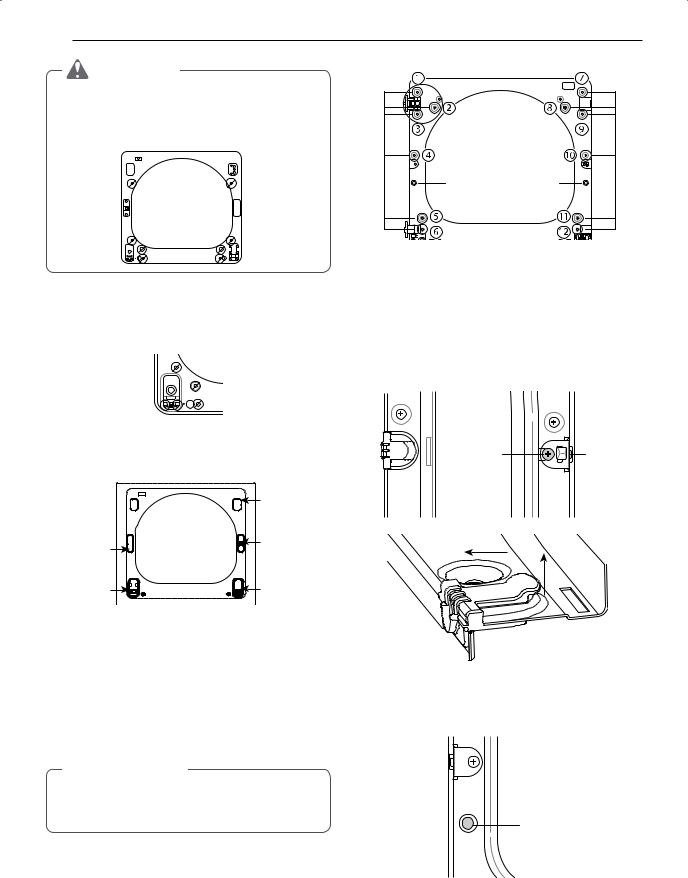
18 INSTALLATION
CAUTION |
Twelve screws |
|
|
|
|
Do NOT remove any of the eight screws on the |
|
|
face of the cabinet (marked below). Doing so |
|
|
could result in damage to the dryer and the need |
|
|
for a service call to repair the dryer. |
|
|
|
Hole |
Side |
|
plug |
Interlock |
|
|
button |
e.Remove the three screws on the hinge at the bottom left. Remove the hinge and reinstall it on the right side. The top screw will occupy the hole where you removed the screw behind the hinge bracket in step d.
5 Switch the door strike and the blank cover.
Remove the two screws on the door cover that secure the door strike.
Switch the door strike and the blank cover, installing them on the opposite sides from which they were removed.
It may be difficult to insert the two screws in the door strike on the opposite side. Use a cordless screwdriver if necessary.
f.Install the hinge bracket removed in step d on the bottom left side, first installing one screw behind the hinge bracket.
Cabinet Reversal complete
|
hinge |
|
cover |
latch hole |
latch |
cover |
mechanism |
hinge |
hinge |
bracket |
|
ON THE DOOR: |
|
4 Lift off the door cover. |
|
With the door laid inside facing up on a protected surface, remove the twelve screws on the
inside of the door. (The two bottom screws wil be different from the rest.) Carefully lift off the door cover with the help of a small flat blade screwdriver inserted in the upper left corner.
 Warning
Warning
The edges of the door cover may be sharp. Take care when handling, or wear gloves to avoid injury.
Short |
Long |
screws |
screw |
Blank cover |
Door strike |
Pull
Raise
Remove blank cover
Gently pry out the hole plug on the side of the door cover and install it in the hole on the opposite side.
Hole plug
Set the door cover aside.
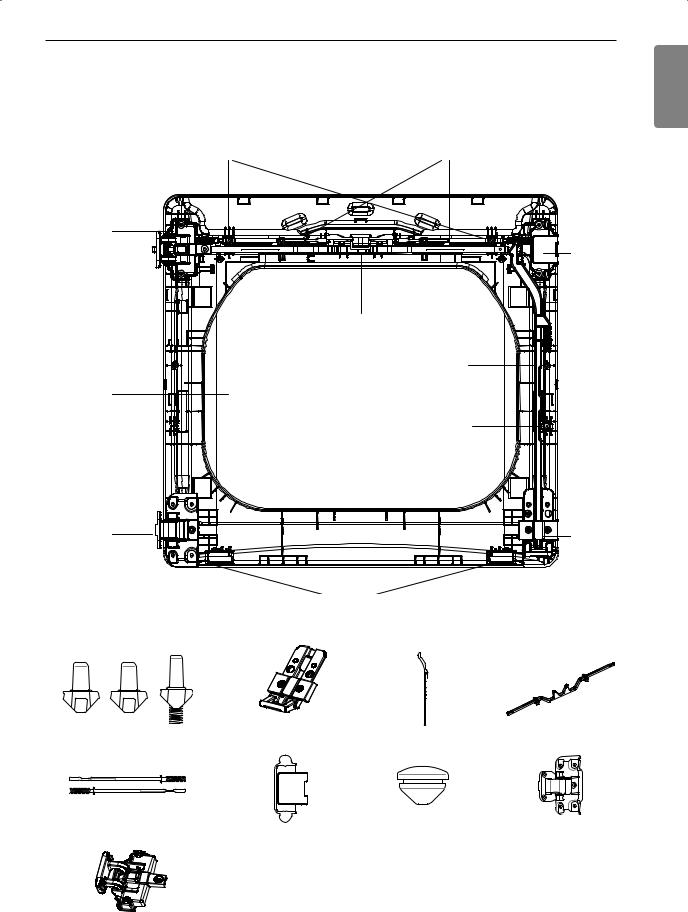
INSTALLATION 19
6 |
Reverse the components inside the door. |
|
|
You will now be removing and reversing various components inside the door. See below for a detailed |
|
|
diagram and identification of the inner structure and parts of the door. (The diagram shows the “before view” |
|
|
of the door, with the default set-up for a right side hinge swing. After following these instructions, the door |
|
|
should be a mirror image of the illustration.) |
|
|
Top interlock buttons |
Inner lock rods |
|
Upper |
|
|
hinge |
|
|
assembly |
Upper |
|
|
|
|
|
hinge filler |
|
|
Top lock rod |
|
|
Side lock rod |
|
Glass |
|
|
|
Side Interlock button |
Lower |
Lower |
hinge |
|
assembly |
hinge |
|
bracket |
|
Bumpers |
Interlock buttons |
Lower hinge bracket |
Side lock rod |
Top lock rod |
Inner lock rods |
Upper hinge filler |
Hole plug |
Lower hinge assembly |
ENGLISH
Upper hinge assembly
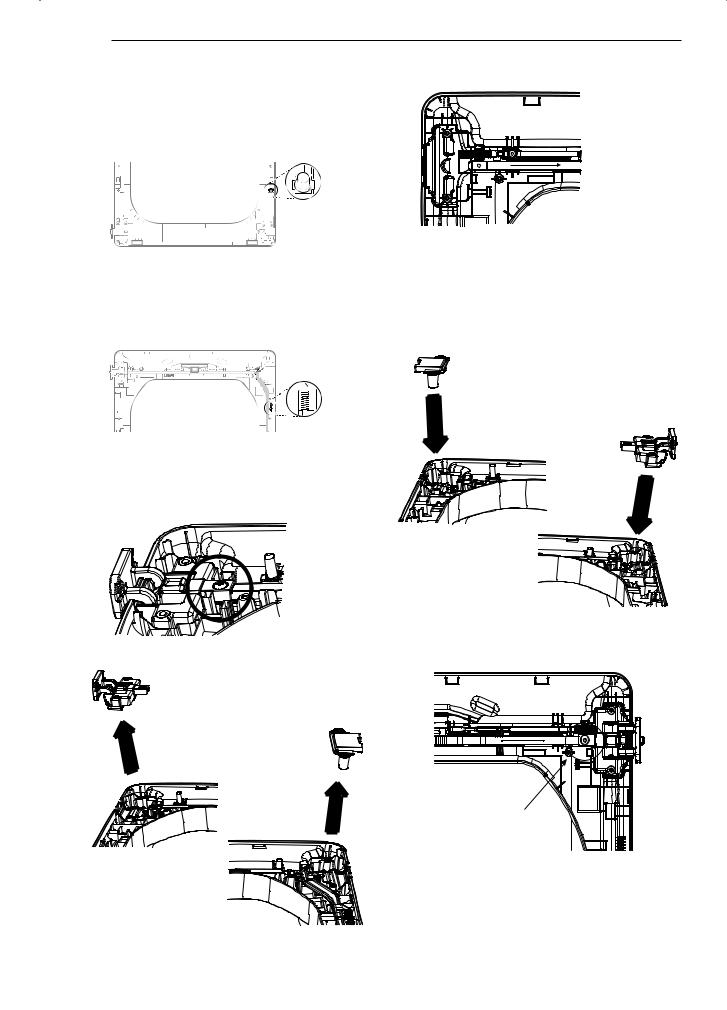
20 INSTALLATION
7 Lift out the gray interlock button in the side of the door.
Make sure to remove the spring with the interlock button and to keep the two together. Set the interlock button aside. Do not confuse this with the interlock buttons from the top of the outer door.
8 Remove the side lock rod.
Remove the side lock rod from the lower hinge bracket by lifting the top end of the rod and sliding it toward the top of the door. The spring should remain attached to the lock rod. Set the lock rod aside.
|
Spring |
9 |
Reverse the upper hinge assembly and hinge |
|
filler. |
a. Remove the screw connecting the upper hinge assembly to the top lock rod and set it aside.
c. Lift out the upper hinge assembly (on the left).
d.Slide the upper lock rod to the right. Rotate the upper hinge assembly 180 degrees, and install it over the lock rod on the right, where you removed the upper hinge filler. Press firmly to fully seat the hinge assembly.
e.Rotate the hinge filler 180 degrees and install it on the upper left side of the door.
b. Lift out the upper hinge filler (on the right) and set it aside.
f. Insert and tighten the screw connecting the upper hinge assembly to the top lock rod, removed in step a.
Assemble screw
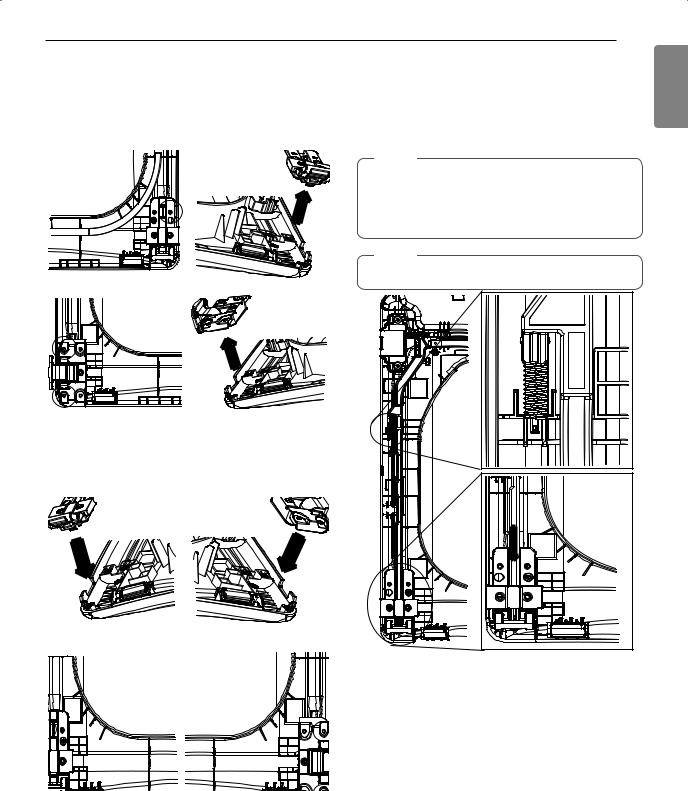
INSTALLATION 21
10 Reverse the lower hinge bracket and hinge assembly.
a. Remove one screw from the lower hinge bracket (on the right) and lift it out. Remove two screws from the lower hinge assembly (on the left) and lift it out.
b.Rotate the lower hinge assembly 180 degrees and install it on the right side using the two screws removed in step a.
c.Mount the lower hinge bracket on the lower left with the screw removed in step a.
11 Install the side lock rod.
a.Flip the side lock rod over and insert the lower end into the left hinge bracket.
b.Lower the rod into the guides on the door while compressing the spring inside the recess.
NOTE
Make sure the top of the side lock rod is beside the top lock rod and the two do not overlap each other. If they are not aligned properly, the door will not operate properly.
NOTE
Make sure the spring stays on the side lock rod.
ENGLISH

22 INSTALLATION
12 Reinstall the side interlock button.
Install the side interlock button on the opposite side from which it was removed.
NOTE
Make sure the spring is on the interlock button and is centered in the compartment.
13 Reinstall the door cover.
a.Clean the glass on the door and door cover, if necessary.
b.Make sure the three gray interlock buttons are properly installed and that the top and side lock rods intersect properly.
c.Carefully lower the door cover into place, aligning the holes in the cover with the three interlock buttons and the bumpers on the bottom edge. You may need to force fit the door cover.
d.Once the door cover is in place, secure it with the 12 screws removed in step 4.
Two different screws
NOTE
Ten similar screws are inserted in the top and sides of the door cover. The two different screws are inserted in the bottom edge.
14 Reassemble the door on cabinet.
While supporting the door, insert the hinge support into the slot in the door and slide the door down slightly to seat it. Install the four hinge screws removed in step 2. Test the swing of the door to check the alignment of the hinges and latch. Make sure the door opens, closes, and latches properly in both directions.
Two large screws
Two small screws
NOTE
If the door is damaged, or if the door does not work after reassembly, contact the call center at 1-800-243-0000.
NOTE
Make sure the three interlock buttons are aligned with the holes in the door cover.
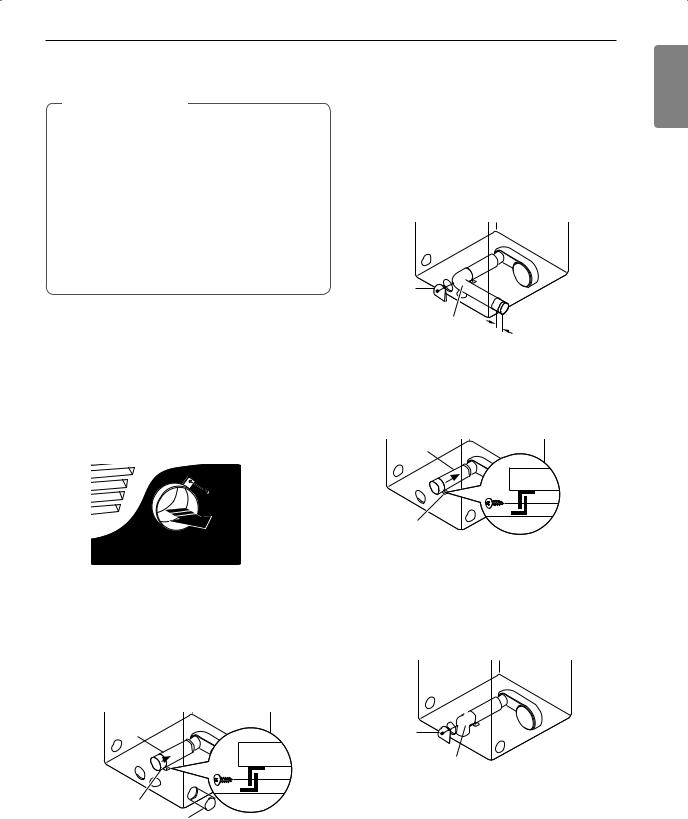
INSTALLATION 23
Installing the Side Vent Kit
 Warning
Warning
•• Use a heavy metal vent.
•• Do not use plastic or thin foil ducts.
•• Clean old ducts before installing this dryer.
•• To reduce the risk of injury to persons, adhere to all industry recommended safety procedures including the use of long-sleeved gloves and safety glasses.
•• Failure to follow all of the safety warnings in this manual could result in property damage, injury to persons, or death.
The dryer is shipped to vent to the rear. It can also be configured to vent to the bottom or side (right-side venting is not available on gas models).
An adapter kit, part number 383EEL9001B, may be purchased from an LG retailer. This kit contains the necessary duct components to change the dryer vent location.
1 |
Remove the rear exhaust duct retaining screw. |
|
Pull out the exhaust duct. |
Retaining Screw
|
Rear Exhaust |
|
Duct |
Option 1: Side Venting |
|
2 |
Press the tabs on the knockout and carefully |
|
remove the knockout for the desired vent |
|
opening (right-side venting is not available on |
|
gas models). Press the adapter duct onto the |
|
blower housing and secure to the base of the |
|
dryer as shown. |
|
Adapter |
|
Duct |
Bracket
Knockout
3 Preassemble a 4-inch (10.2 cm) elbow to the next 4-inch (10.2 cm) duct section, and secure all joints with duct tape. Be sure that the male end of the elbow faces AWAY from the dryer. Insert the elbow/duct assembly through the side opening and press it onto the adapter duct. Secure it in place with duct tape. Be sure that the male end of the duct protrudes 1½ inches (3.8 cm) to connect the remaining ductwork. Attach the cover plate to the back of the dryer with the included screw.
Cover |
|
Plate |
|
Elbow |
1½" |
|
(3.8 cm) |
Option 2: Bottom Venting
2 |
Press the adapter duct onto the blower housing |
|
and secure it to the base of the dryer as shown. |
|
Adapter |
|
Duct |
|
Bracket |
3 |
Insert the 4-inch (10.2 cm) elbow through the |
|
rear opening and press it onto the adapter duct. |
Be sure that the male end of the elbow faces down through the hole in the bottom of the dryer. Secure it in place with duct tape. Attach the cover plate to the back of the dryer with the included screw.
Cover
Plate
Elbow
ENGLISH
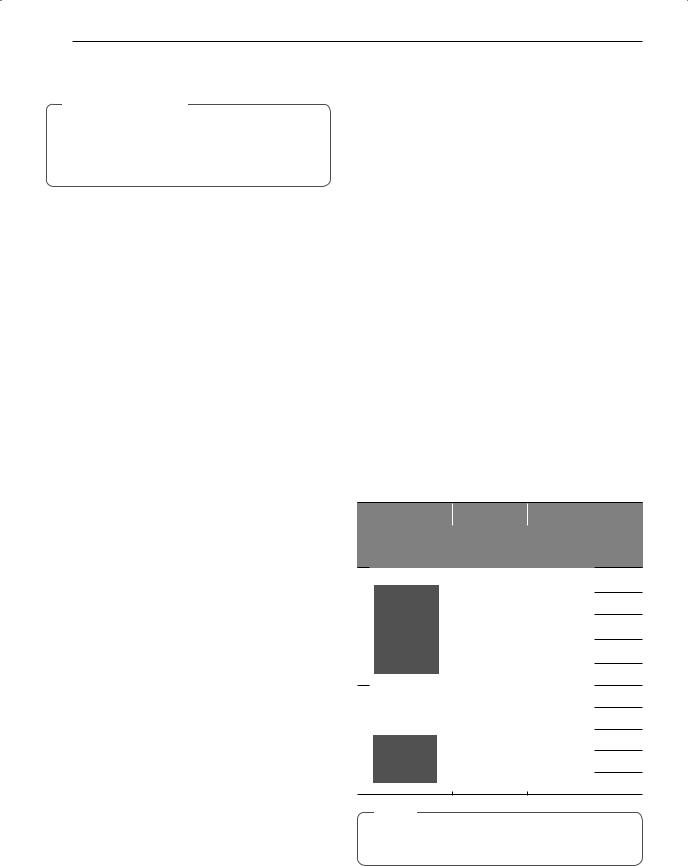
24 INSTALLATION
Venting the Dryer
 Warning
Warning
To reduce the risk of fire or explosion, electric shock, property damage, injury to persons or death when using this appliance, follow basic safety precautions, including the following:
•• Do not crush or collapse ductwork. Failure to follow these instructions may result in fire or death.
•• Do not allow ductwork to rest on or contact sharp objects. Failure to follow these instructions may result in fire or death.
•• If connecting to existing ductwork, make sure it is suitable and clean before installing the dryer.
Failure to follow these instructions may result in fire or death.
•• Venting must conform to local building codes.
Failure to follow these instructions may result in fire or death.
•• Gas dryers MUST exhaust to the outdoors.
Failure to follow these instructions may result in fire or death.
•• Use only 4-inch (10.2 cm) rigid, semi-rigid or flexible metal ductwork inside the dryer cabinet and for venting outside. Failure to follow these instructions may result in fire or death.
•• To reduce the risk of fire, combustion, or accumulation of combustible gases, DO NOT exhaust dryer air into an enclosed and
unventilated area, such as an attic, wall, ceiling, crawl space, chimney, gas vent, or concealed space of a building. Failure to follow these instructions may result in fire or death.
•• To reduce the risk of fire, DO NOT exhaust the dryer with plastic or thin foil ducting. Failure to follow these instructions may result in fire or death.
•• The exhaust duct must be 4 inches (10.2 cm) in diameter with no obstructions. The exhaust duct should be kept as short as possible. Make sure to clean any old ducts before installing
your new dryer. Failure to follow these instructions may result in fire or death.
•• Rigid, semi-rigid or flexible metal ducting is recommended for use between the dryer and the wall. All non-rigid metal transition duct must be UL-listed. Use of other materials for transition duct could affect drying time. Failure to follow these instructions may result in fire or death.
•• DO NOT use sheet metal screws or other fasteners which extend into the duct that could catch lint and reduce the efficiency of the exhaust system. Secure all joints with duct tape. Failure to follow these instructions may result in fire or death.
•• Do not exceed the recommended duct length limitations noted in the chart. Failure to follow these instructions may result in extended drying times, fire or death.
•• Ductwork is not provided with the dryer. You should obtain the necessary ductwork locally. The vent hood should have hinged dampers to prevent backdraft when the dryer is not in use.
Failure to follow these instructions may result in fire or death.
•• The total length of flexible metal duct must not exceed 8 ft. (2.4 m).
•• In Canada, only those foil-type flexible ducts, if any, specifically identified for use with the appliance by the manufacturer should be used.
In the United States, only those foil-type flexible ducts, if any, specifically identified for use with the appliance by the manufacturer and that comply with the Outline for Clothes Dryer Transition Duct, Subject 2158A, should be used.
Ductwork
|
Number |
Maximum length |
|
|
of 4-inch (10.2 cm) |
||
Wall Cap Type |
of 90° |
||
diameter rigid metal |
|||
|
Elbows |
||
|
duct |
||
|
|
||
Recommended |
0 |
65 ft.(19.8 m) |
|
|
1 |
55 ft.(16.8 m) |
|
4" |
2 |
47 ft.(14.3 m) |
|
(10.2 cm) |
|||
4" |
3 |
36 ft.(11.0 m) |
|
|
|
||
(10.2 cm) |
4 |
28 ft.(8.5 m) |
|
|
|||
Use only for |
0 |
55 ft.(16.8 m) |
|
|
|
||
short run |
1 |
47 ft.(14.3 m) |
|
installations |
2 |
41 ft.(12.5 m) |
|
|
|||
21/2" |
3 |
30 ft.(9.1 m) |
|
(6.35 cm) |
4 |
22 ft.(6.7 m) |
|
|
NOTE
Deduct 6 ft. (1.8 m) for each additional elbow. Do not use more than four 90° elbows.
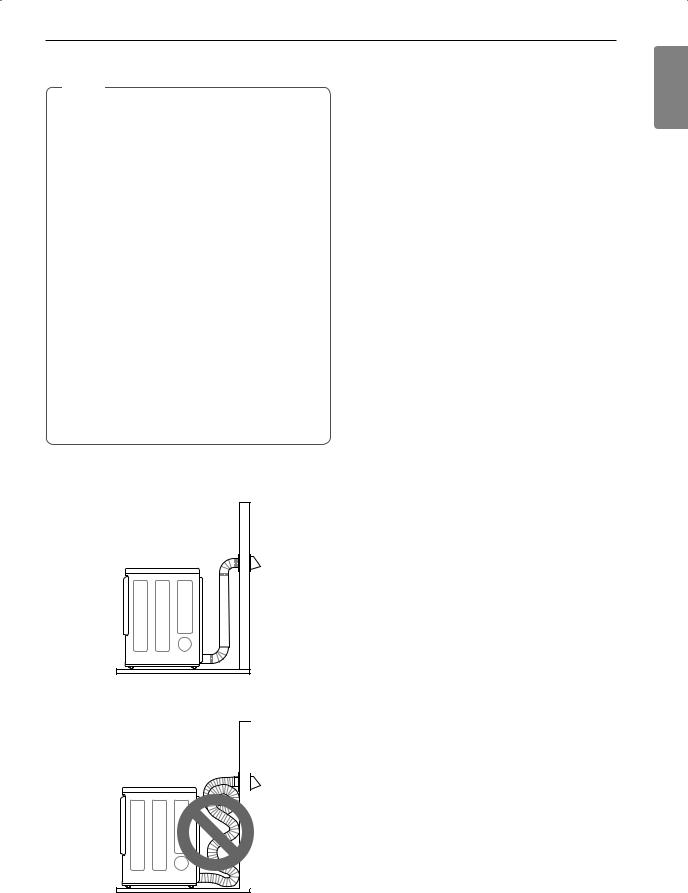
Routing And Connecting Ductwork
NOTE
Follow the guidelines below to maximize drying performance and reduce lint buildup and condensation in the ductwork. Ductwork and fittings are NOT included and must be purchased separately.
•• Use 4-inch (10.2 cm) diameter rigid, semi-rigid or flexible metal ductwork.
•• The exhaust duct run should be as short as possible.
•• Use as few elbow joints as possible.
•• The male end of each section of exhaust duct must point away from the dryer.
•• Use duct tape on all duct joints.
•• Insulate ductwork that runs through unheated areas in order to reduce condensation and lint buildup on duct surfaces.
•• Incorrect or inadequate exhaust systems are not covered by the dryer warranty. Dryer failures or service required because of such exhaust systems will not be covered by the dryer warranty.
Correct Venting
Incorrect Venting
INSTALLATION 25
ENGLISH
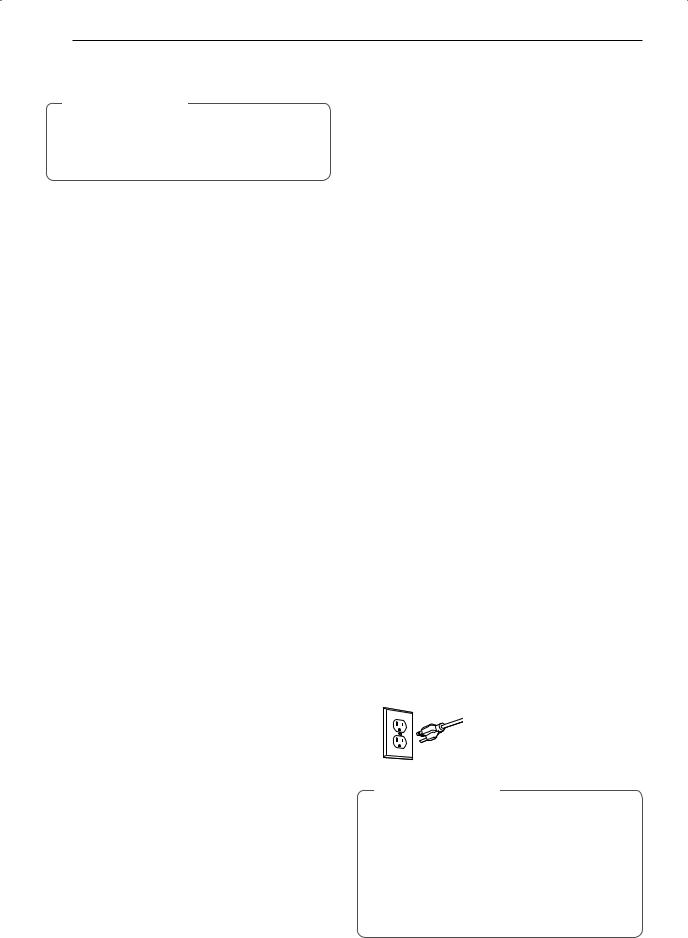
26 INSTALLATION
Connecting Gas Dryers
 Warning
Warning
To reduce the risk of fire or explosion, electric shock, property damage, injury to persons, or death when using this appliance, follow basic safety precautions.
Gas Supply Requirements
•• As shipped from the factory, this dryer is configured for use with natural gas (NG). It can be converted for use with propane (LP) gas. Gas pressure must not exceed 8 inches
(20.3 cm) of water column for NG, or 13 inches (33 cm) of water column for LP.
•• A qualified service or gas company technician must connect the dryer to the gas service. Failure to follow these instructions may result in fire, explosion, or death.
•• Isolate the dryer from the gas supply system by closing its individual manual shutoff valve during any pressure testing of the gas supply.
Failure to do so may result in fire, explosion, or death.
•• Supply line requirements: Your laundry room must have a rigid gas supply line to the dryer. In the United States, an individual manual shutoff valve MUST be installed within at least 6 ft. (1.8 m) of the dryer, in accordance with the National Fuel Gas Code ANSI Z223.1 or Canadian gas installation code CSA B149.1. A 1/8-inch (0.3 cm) NPT pipe plug must be installed. Failure to do so may result in fire, explosion, or death.
•• If using a rigid pipe, the rigid pipe should be
½ inch IPS. If acceptable under local codes and ordinances and when acceptable to your gas supplier, 3/8-inch (1 cm) approved tubing may be used where lengths are less than 20 ft.
(6.1 m). Larger tubing should be used for lengths in excess of 20 ft. (6.1 m). Failure to do so may result in fire, explosion, or death.
•• Connect the dryer to the type of gas shown on the nameplate. Failure to do so may result in fire, explosion, or death.
•• To prevent contamination of the gas valve, purge the gas supply of air and sediment before connecting the gas supply to the dryer. Before tightening the connection between the gas supply and the dryer, purge remaining air until the odor of gas is detected. Failure to do so may result in fire, explosion, or death.
•• DO NOT use an open flame to inspect for gas leaks. Use a noncorrosive leak detection fluid.
Failure to do so may result in fire, explosion, or death.
•• Use only a new AGAor CSA-certified gas supply line with flexible stainless steel connectors. Failure to do so may result in fire, explosion, or death.
•• Securely tighten all gas connections. Failure to do so may result in fire, explosion, or death.
•• Use Teflon tape or a pipe-joint compound that is insoluble in propane (LP) gas on all pipe threads. Failure to do so may result in fire, explosion, or death.
•• DO NOT attempt any disassembly of the dryer; disassembly requires the attention and tools of an authorized and qualified service technician or company. Failure to follow this warning may result in fire, explosion, or death.
Electrical Requirements for Gas Models Only
•• Do not, under any circumstances, cut or remove the third (ground) prong from the power cord.
Failure to follow this warning may result in fire, explosion, or death.
•• For personal safety, this dryer must be properly grounded. Failure to follow this warning may result in fire, explosion, or death.
•• This dryer must be plugged into a 120-VAC,
60-Hz. grounded outlet protected by a 15-ampere fuse or circuit breaker. Failure to follow this warning may result in fire, explosion, or death.
•• Where a standard 2-prong wall outlet is encountered, it is your personal responsibility and obligation to have it replaced with a properly grounded 3-prong wall outlet. Failure to follow this warning may result in fire, explosion, or death.
Plugdrdryerer intointoa a 120 VAC,
60 Hz grounded 3-prong outlet.
 Warning
Warning
ELECTRIC SHOCK HAZARD
Failure to follow safety warnings could result in serious injury or death.
This dryer is equipped with a three-prong grounding plug for protection against shock hazard and should be plugged directly into a properly grounded three-prong receptacle. Do not cut or remove the grounding prong from this plug.
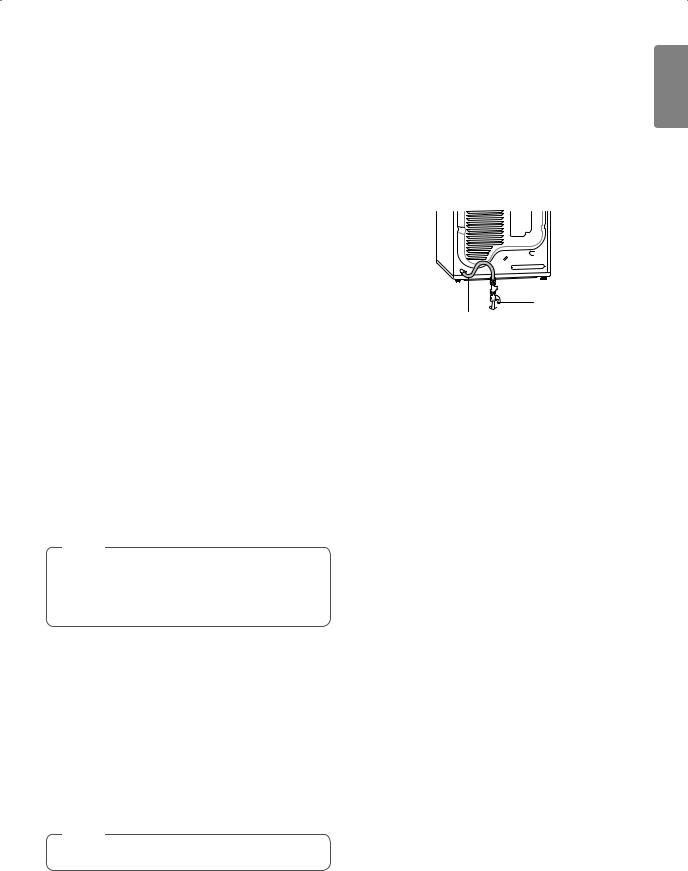
|
|
INSTALLATION 27 |
||
|
|
|
|
|
Connecting the Gas Supply |
4 |
Securely tighten all connections between the |
||
•• Installation and service must be performed |
|
dryer and your laundry room’s gas supply. |
||
|
|
|
||
by a qualified installer, service agency, or the |
5 |
Turn on your laundry room’s gas supply. |
||
gas supplier. Failure to do so may result in fire, |
||||
explosion, or death. |
6 |
Check all pipe connections (both internal and |
||
•• Use only a new stainless steel flexible |
||||
|
external) for gas leaks with a noncorrosive leak- |
|||
connector and a new AGA-certified connector. |
|
detection fluid. |
||
Failure to do so may result in fire, explosion, or |
7 |
Proceed to Venting the Dryer. |
||
death. |
||||
•• A gas shutoff valve must be installed within 6 ft. |
|
|
|
|
(1.8 m) of the dryer. Failure to do so may result in |
|
|
|
|
fire, explosion, or death. |
|
|
|
|
•• The dryer is configured for natural gas when shipped from the factory. Make sure that the dryer is equipped with the correct burner nozzle for the type of gas being used (natural gas or propane gas). Failure to do so may result in fire, explosion, or death.
•• If necessary, the correct nozzle (for the LP nozzle kit, order part number 383EEL3002D) should be installed by a qualified technician and the change should be noted on the dryer.
Failure to do so may result in fire, explosion, or death.
•• All connections must be in accordance with local codes and regulations. Failure to do so may result in fire, explosion, or death.
•• Gas dryers MUST exhaust to the outdoors.
Failure to do so may result in fire, explosion, or death.
NOTE
3/8" 
 NPT gas
NPT gas 
 Connection
Connection 
AGA/CSA-Certified
Stainless Steel Flexible Connector
1/8" NPT Pipe Plug
Gas Supply Shutoff
Valve
High-Altitude Installations
The BTU rating of this dryer is AGA-certified for elevations below 10,000 feet.
If your gas dryer is being installed at an elevation above 10,000 feet, it must be derated by a qualified technician or gas supplier.
This dryer is configured from the factory for natural gas (NG). If the dryer is to be used with propane (LP) gas, it must be converted by a qualified service technician.
1 |
Make sure that the gas supply to the laundry |
|
room is turned OFF and the dryer is unplugged. |
|
Confirm that the type of gas available in your |
|
laundry room is appropriate for the dryer. |
2 |
Remove the shipping cap from the gas fitting at |
|
the back of the dryer. Be careful not to damage |
|
the threads of the gas connector when removing |
|
the shipping cap. |
3 |
Connect the dryer to your laundry room’s gas |
supply using a new flexible stainless steel connector with a 3/8-inch NPT fitting.
NOTE
DO NOT use old connectors.
ENGLISH

28 INSTALLATION
Connecting Electric Dryers
Electrical Requirements for Electric Models Only
 Warning
Warning
To help prevent fire, electric shock, serious injury, or death, the wiring and grounding must conform to the latest edition of the National Electrical Code, ANSI/NFPA 70 and all applicable local regulations. Please contact a qualified electrician to check your home’s wiring and fuses to ensure that your home has adequate electrical power to operate the dryer.
•• This dryer must be connected to a grounded metal, permanent wiring system, or an equipment-grounding conductor must be run with the circuit conductors and connected to the equipment-grounding terminal or lead on the dryer. Failure to do so may result in fire, explosion, or death.
•• The dryer has its own terminal block that must be connected to a separate 240 VAC, 60-Hertz, single-phase circuit, fused at 30 amperes (the circuit must be fused on both sides of the line). ELECTRICAL SERVICE FOR THE DRYER
SHOULD BE OF THE MAXIMUM RATE VOLTAGE LISTED ON THE NAMEPLATE. DO NOT CONNECT THE DRYER TO 110-, 115-, OR 120VOLT CIRCUIT. Failure to follow these instructions may result in fire, explosion, or death.
•• If the branch circuit to dryer is 15 ft. (4.5 m) or less in length, use UL (Underwriters Laboratories) listed No. 10 AWG wire (copper wire only), or as required by local codes. If over 15 ft. (4.5 m), use UL-listed No. 8 AWG
wire (copper wire only), or as required by local codes. Allow sufficient slack in wiring so the dryer can be moved from its normal location when necessary. Failure to do so may result in fire, explosion, or death.
•• The power cord (pigtail) connection between the wall receptacle and the dryer terminal block IS NOT supplied with the dryer. Type of pigtail and gauge of wire must conform to local codes and with instructions on the following pages.
Failure to follow these instructions may result in fire, explosion, or death.
•• A 4-wire connection is required for all mobile and manufactured home installations, as well as all new construction after January 1, 1996. A 4-wire connection must be used where local codes do not permit grounding through the neutral wire. Failure to do so may result in fire, explosion, or death.
•• Do not modify the plug and internal wire provided with the dryer.
•• The dryer should be connected to a 4-hole outlet.
•• If the plug does not fit the outlet, a proper outlet will need to be installed by a qualified electrician.
Special Electrical Requirements for Mobile or Manufactured Homes
•• Any installation in a manufactured or mobile home must comply with the Manufactured Home Construction and Safety Standards Title 24 CFR, Part 3280 or Standard CAN/ CSA Z240 MH and local codes and ordinances. If you are uncertain whether your proposed installation will comply with these standards, please contact a service and installation professional for assistance.
•• A 4-wire connection is required for all mobile and manufactured home installations, as well as all new construction after January 1, 1996.
Failure to do so may result in fire, explosion, or death.
•• A gas dryer must be permanently attached to the floor.
•• The electrical connection for an electric dryer must be a 4-wire connection. More detailed information concerning the electrical connection is provided in the Connecting Electric Dryers section.
•• To reduce the risk of combustion and fire, the dryer must be vented to the outside.
•• DO NOT vent the dryer under a manufactured home or mobile home.
•• Electric dryers may be vented to the outside using the back, left, right, or bottom panel.
•• Gas dryers may be vented to the outside using the back, left, or bottom panel. Gas dryers may not be vented to the outside using the right side panel because of the burner housing.
•• The dryer exhaust duct must be affixed securely to the manufactured or mobile home structure, and the exhaust duct must be made of a material that will resist fire and combustion. It is recommended that you use a rigid, semi-rigid or flexible metal duct.
•• DO NOT connect the dryer exhaust duct to any other duct, vent, chimney, or other exhaust duct.
•• Make sure the dryer has adequate access to outside fresh air to ensure proper operation. The opening for outside fresh air must be at least 25 sq. in (163 cm2).
•• It is important that the clearance of the duct from any combustible construction be at least 2 inches (5 cm), and when venting the dryer to the outdoors, the dryer should be installed with a clearance of at least 1 inch (2.5 cm) at the sides and back of the dryer.
•• Venting materials are not supplied with the dryer. You must obtain the venting materials necessary for proper installation.
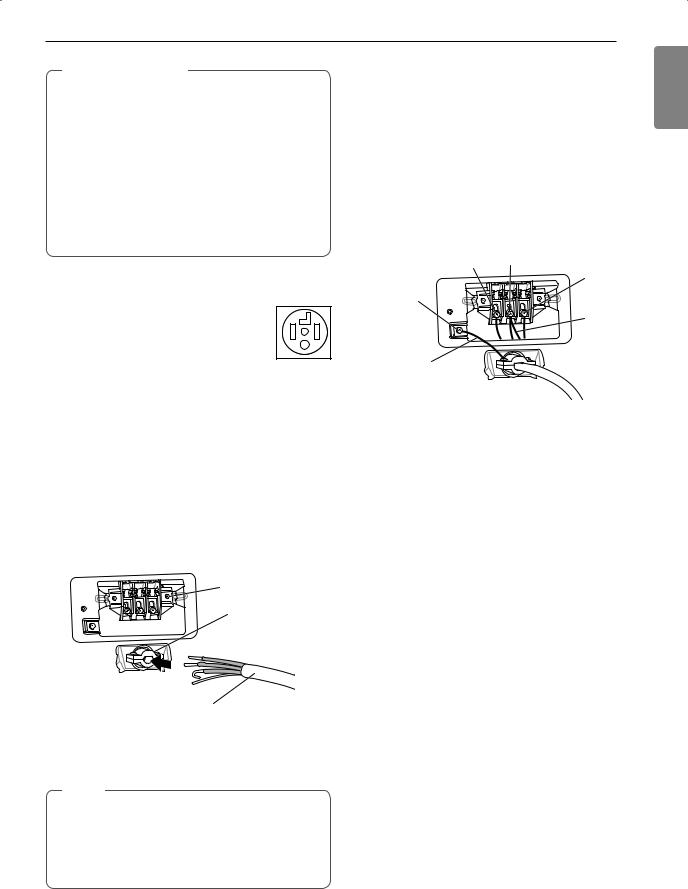
INSTALLATION 29
 Warning
Warning
Connect the power cord to the terminal block. Connect each wire in the power cord to the terminal block screw with the matching colored wire. The terminal block wire colors are indicated in the manual. Failure to follow these instructions may result in a short or overload.
Grounding through the neutral conductor is prohibited for: (1) new branch-circuit installations,
(2) mobile homes, (3) recreational vehicles, and
(4) areas where local codes prohibit grounding through the neutral conductor.
Four-Wire Power Cord
•• A 4-wire connection is required for all mobile and manufactured home installations, as well as all new construction after January 1, 1996.
•• A UL-listed strain relief is required.
•• Use a 30-amp, 240-volt, 4-wire, UL-listed power cord with #10 AWG-minimum copper conductor and closed loop or forked terminals with upturned ends.
1 |
Remove the terminal block access cover on the |
|
upper back of the dryer. |
2 |
Install a UL-listed strain relief into the power cord |
|
through-hole. |
3 |
Thread a 30-amp, 240-volt, 4-wire, UL-listed |
|
power cord with #10 AWG-minimum copper |
|
conductor through the strain relief. |
Terminal Block
UL-Listed
Strain Relief
UL-Listed 4-Wire Power Cord
4 Transfer the dryer’s ground wire from behind the green ground screw to the center screw of the terminal block.
NOTE
5 |
Attach the two hot leads of the power cord to the |
|
|
outer terminal block screws. |
|
6 |
Attach the white neutral wire to the center screw |
|
|
of the terminal block. |
|
7 |
Attach the power cord ground wire to the green |
|
|
ground screw. |
|
8 |
Tighten all screws securely. |
|
9 |
Reinstall the terminal block access cover. |
|
|
Hot |
Neutral |
|
(Black) |
(White) |
|
|
Hot |
|
Ground |
(Red) |
|
|
|
|
Screw |
White Wire |
|
|
|
|
|
moved from |
|
|
Ground |
|
Power Cord |
Screw |
|
|
|
|
Ground Wire |
|
This dryer is supplied with the neutral wire grounded. This white ground wire MUST BE MOVED to the neutral terminal when a 4-wire cord is to be used, or where grounding through the neutral conductor is prohibited.
ENGLISH
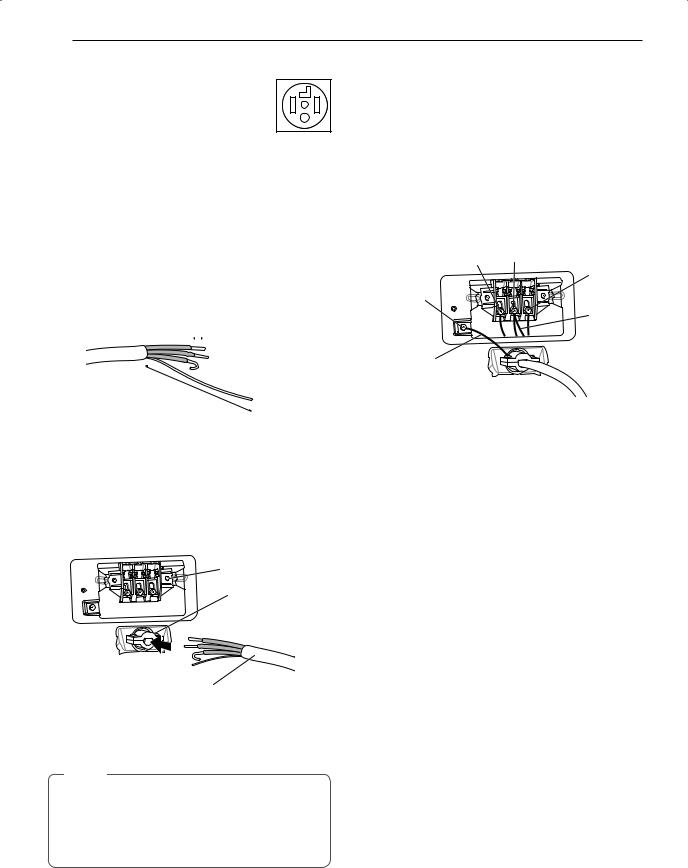
30 INSTALLATION
Four-Wire Direct Wire
•• A 4-wire connection is required for all mobile and manufactured home installations, as well as all new construction after January 1, 1996.
•• A UL-listed strain relief is required.
•• Use UL-listed 4-wire #10 AWG-minimum copper conductor cable. Allow at least 5 ft. (1.5 m) of wire to allow for removal and reinstallation of the dryer.
1 |
Remove 5 inches (12.7 cm) of the outer covering |
|||||
|
from the wire. Remove 5 inches (12.7 cm) |
|||||
|
of insulation from the ground wire. Cut off |
|||||
|
approximately 1½ inches (3.8 cm) from the other |
|||||
|
three wires and strip 1 inch (2.5 cm) of insulation |
|||||
|
from each wire. Bend the ends of the three |
|||||
|
shorter wires into a hook shape. |
|||||
|
|
1" (2.5 cm) |
||||
|
|
|
|
Ground Wire |
||
|
|
|
|
|||
|
|
|||||
|
5" |
|
|
|
|
|
2 |
|
(12.7 cm) |
|
|
||
|
|
|||||
Remove the terminal block access cover on the |
||||||
|
upper back of the dryer. |
|||||
3 |
Install a UL-listed strain relief into the power cord |
|||||
|
through-hole. |
|||||
4 |
Thread the 4-wire #10 AWG-minimum copper |
|||||
power cable prepared in step 1 through the strain relief.
Terminal Block
UL-Listed
Strain Relief
UL-Listed 4-Wire Power Cord
5 Transfer the dryer’s ground wire from behind the green ground screw to the center screw of the terminal block.
NOTE
6 |
Attach the two hot leads of the power cord to the |
|
outer terminal block screws. |
7 |
Attach the white neutral wire to the center screw |
|
of the terminal block. |
8 |
Attach the power cord ground wire to the green |
|
ground screw. |
9 Tighten all screws securely.
10 Reinstall the terminal block access cover.
Hot |
Neutral |
(Black) |
(White) |
|
Hot |
Ground |
(Red) |
|
|
Screw |
White Wire |
|
|
|
moved from |
|
Ground |
Power Cord |
Screw |
|
|
Ground Wire |
|
This dryer is supplied with the neutral wire grounded. This white ground wire MUST BE MOVED to the neutral terminal when a 4-wire cord is to be used, or where grounding through the neutral conductor is prohibited.
